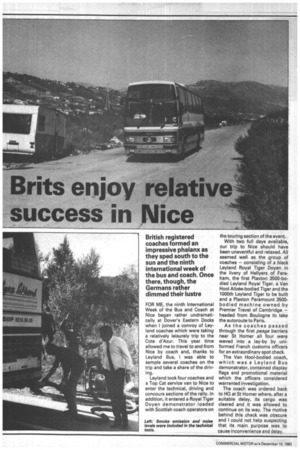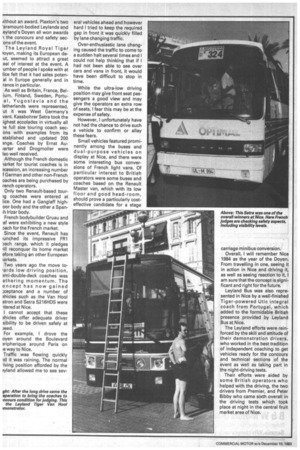British registered coaches formed an impressive phalanx as they sped
Page 80

Page 81

Page 82

If you've noticed an error in this article please click here to report it so we can fix it.
south to the sun and the ninth international week of the bus and coach. Once there, though, the Germans rather dimmed their lustre
FOR ME, the ninth International Week of the Bus and Coach at Nice began rather undramatically at Dover's Eastern Docks when I joined a convoy of Leyland coaches which were taking a relatively leisurely trip to the Cote d'Azur. This year time allowed me to travel to and from Nice by coach and, thanks to Leyland Bus, I was able to sample several coaches on the trip and take a share of the driving.
Leyland took four coaches and a Top Cat service van to Nice to enter the technical, driving and concours sections of the rally. In addition, it entered a Royal Tiger Doyen demonstrator loaded with Scottish coach operators on the touring section of the event.
With two full days available, our trip to Nice should have been uneventful and relaxed. All seemed well as the group of coaches — consisting of a black Leyland Royal Tiger Doyen in the livery of Hellyers of Fareham, the first Plaxton 3500-bodied Leyland Royal Tiger, a Van Hool Alizee-bodied Tiger and the 1000th Leyland Tiger to be built and a Plaxton Paramount 3500bodied machine owned by Premier Travel of Cambridge — headed from Boulogne to take the autoroute to Paris.
As the coaches passed through the first peage barriers near St Homer all four were waved into a lay-by by uniformed French customs officers for an extraordinary spot check.
The Van Hool-bodied coach, which was a Leyland Bus demonstrator, contained display flags and promotional material which the officers considered warranted investigation.
The coach was ordered back to HO at St Homer where, after a suitable delay, its cargo was cleared and it was allowed to continue on its way. The motive behind this check was obscure and I could not help suspecting that its main purpose was to cause inconvenience and delay. While the Van Hool was delayed, I was lucky enough to be travelling on the black Doyen, Driving the Hydracyclic transmission coach was as much a pleasure as riding in it as a passenger. The more I travelled in it, the more I felt sure that it represents the right concept for future long-distance coaches.
I like the approach to the interior trim, which I find soft and restful, and I found the ride particularly pleasant.
However, I did find a few points to criticise on the Doyen and all of these derived from a lack of attention to detail. The plug-type door fitted well but needed an extra manual tug to avoid wind noise from the top; there were annoying rattles from the sun blinds; and the interior mirror was obscured by the sun visor.
We covered the long journey to Nice completely on French toll motorways and stuck religiously to 90km/h (56mph) speed limit. During the stretches when I drove, I appreciated the need for a lower limit than in Britain because of the noticeably narrower lanes, but I did find reining the coach back to this relatively slow speed both frustrating and tiring.
Once over the hill and in the south of France, British style October weather gave way to French summer at its best and we arrived in Nice.
The rally proper started with technical tests on a disused section of road, which seemed to be normally used as an unofficial rubbish tip. The tests, which in previous years had taken place on a closed section of the Promenade des Anglaise, were relevant and included drive past and interior noise levels, brak
ing, suspension and exhaust emission chocks.
After completing the technical tests, coaches were parked along the seafront to be cleaned ready for judging and public and professional admiration.
It is appropriate that more British registered coaches than in previous years found their way to Nice since many operate regular shuttles to the region, and it was noticeable that this year the British-entered coaches were equal in all respects to any of their European counterparts and indeed were better than many.
Overall, I found the collection of coaches at Nice a trifle disappointing. There was little that had not been on show before. Probably the most obvious trend was towards high-specification British coaches.
The British-registered coaches in the event included the Leyland contingent and a Jonckheere P90-bodied Volvo B1 OM owned by Gilbert Kinch, a Plaxton Paramount 3500-bodied Daf M82 0 0 DKEL of Globe of Barnsley, and a Daf 2300 SB with low driving position Jonckheere P599 Jubilee body entered by Youngs of Cambridge.
Only the Globe Daf went home rithout an award. Plaxton's two 'aramount-bodied Leylands and eyland's Doyen all won awards the concours and safety secons of the event.
The Leyland Royal Tiger Ioyen, making its European deut, seemed to attract a great eal of interest at the event. A umber of people I spoke with at lice felt that it had sales potenal in Europe generally and in rance in particular.
As well as Britain, France, Belium, Finland, Sweden, Portual, Yugoslavia and the letherlands were represented, ut it was West Germany's vent. Kassbohrer Setra took the ighest accolades in virtually all le full size touring coach secons with examples from its stablished and updated 200 3nge. Coaches by Ernst Autarter and Drogmoller were
Iso well received.
Although the French domestic
larket for tourist coaches is in 3cession, an increasing number f German and other non-French oaches are being purchased by rench operators.
Only two Renault-based tourig coaches were entered at lice. One had a Ganglaff highoor body and the other a Span;h Irizar body.
French bodybuilder Gruau and af were exhibiting a new style oach for the French market. Since the event, Renault has lunched its impressive FR1 oach range, which it pledges reconquer its home market efore taking on other European larkets.
Two years ago the move to'ards low driving position, ami-double-deck coaches was athering momentum. The oncept has now gained ceptance and a number of .ahicles such as the Van Hool stron and Setra S216HDS were itered at Nice.
I cannot accept that these 3hicles offer adequate driver sibility to be driven safely at )eed.
For example, I drove the oyen around the Boulevard aripherique around Paris on le way to Nice.
Traffic was flowing quickly id it was raining. The normal -lying position afforded by the ayland allowed me to see sev
eral vehicles ahead and however hard I tried to keep the required gap in front it was quickly filled by lane changing traffic.
Over-enthusiastic lane changing caused the traffic to come to a sudden halt several times and I could not help thinking that if I had not been able to see over cars and vans in front, it would have been difficult to stop in time.
While the ultra-low driving position may give front seat passengers a good view and may give the operators an extra row of seats, I fear this may be at the expense of safety.
However, I unfortunately have not had the chance to drive such a vehicle to confirm or allay these fears.
Small vehicles featured prominently among the buses and dual-purpose vehicles on display at Nice, and there were some interesting bus conversions of French light vans. Of particular interest to British operators were some buses and coaches based on the Renault Master van, which with its low floor and good head-room, should prove a particularly costeffective candidate for a stage carriage minibus conversion.
Overall, I will remember Nice 1984 as the year of the Doyen. From travelling in one, seeing it in action in Nice and driving it, as well as seeing reaction to it, I am sure that the concept is significant and right for the future.
Leyland Bus was also represented in Nice by a well-finished Tiger-powered Utic integral coach from Portugal, which added to the formidable British presence provided by Leyland Bus at Nice.
The Leyland efforts were reinforced by the skill and attitude of their demonstration drivers, who worked in the best tradition of independent coaching to get vehicles ready for the concours and technical sections of the event as well as taking part in the night-driving tests.
Their efforts were aided by some British operators who helped with the driving, the two drivers from Premier, and Peter Bibby who came sixth overall in the driving tests which took place at night in the central fruit market area of Nice.












































































































